Seven Questions Over Breakfast
(Plus a Martini or Two) with Barry Moser
 December 10th, 2009 by jules
December 10th, 2009 by jules
 Welcome, dear readers, to an interview I very much enjoyed formatting. I’m not only a long-time fan of Barry Moser’s printwork and watercolors, but I also particularly enjoyed reading his honest and insightful responses to my questions. Though you will read below his perfectly understand-
Welcome, dear readers, to an interview I very much enjoyed formatting. I’m not only a long-time fan of Barry Moser’s printwork and watercolors, but I also particularly enjoyed reading his honest and insightful responses to my questions. Though you will read below his perfectly understand-
able reasons for expatriating from the South, a part of Moser still feels affinity towards it; he, in fact, grew up in East Tennessee (born in Chattanooga, to be exact, in 1940), where I also lived for quite some time. And, speaking of the South, his response to the Pivot pearly-gates question is my New Favorite Ever.
Moser is not only an accomplished and renowned illustrator (in both painting and print-making); he is also a printer, typographer, calligraphy artist, designer, lecturer, author, essayist, and teacher. And a “booksmith,” as he told Anna Olswanger in this 1999 interview, adding “{m}y skin goes a little rankly on ‘children’s book illustrator.’ That’s an artificial subdivision. You’re either a book illustrator, or you’re not.” As the owner of the private Pennyroyal Press, his own imprint, Moser strives “to do…as beautiful a book as I can possibly do” (source here); he has illustrated and/or designed over three hundred titles for both children and adults.
Working primarily in watercolors for children’s titles, Barry’s most recent title is the beautiful Once Upon a Twice (Random House, August 2009), written by Denise Doyen. You can re-visit this post to read more about the book. Moser’s paintings in this clever title are “a marvel of nighttime beauty,” wrote Publishers Weekly. In describing his illustrations for Cynthia Rylant’s Appalachia: The Voices of Sleeping Birds (Harcourt, 1991), I think Publishers Weekly’s comment captures well what Moser brings to any title he illustrates: “Moser’s masterfully executed paintings…find beauty in plainness, capturing the culture and people…with affection and sensitivity.”
This morning, Barry is joining me for some “Eggs Benedict.” I’m all for that. Let’s set the table for our breakfast chat and get the basics from Barry in the process. I thank him for stopping by.
 7-Imp: Are you an illustrator or author/illustrator?
7-Imp: Are you an illustrator or author/illustrator?
Barry: Both, but primarily illustrator.
7-Imp: Can you list your books-to-date?
Barry: Ninety-three (or so) for children; nearly three hundred for adults. You can find a complete bibliography on my website.
7-Imp: What is your usual medium, or––if you use a variety—your preferred one?
Barry: For children’s books: transparent watercolor.
7-Imp: If you have illustrated for various age ranges (such as, both picture books and early reader books OR, say, picture books and chapter books), can you briefly discuss the differences, if any, in illustrating for one age group to another?
Barry: For me, there is no difference other than tone. The younger the audience, the more humorous the pictures.
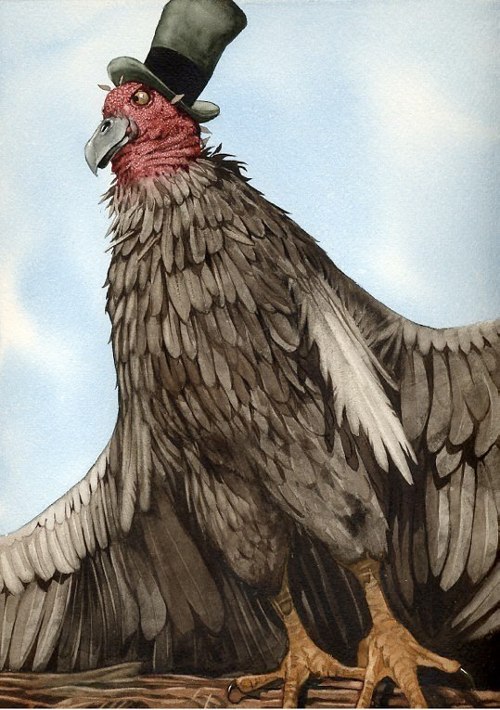
When Birds Could Talk and Bats Could Sing
(Blue Sky Press, 1996)
7-Imp: Where are your stompin’ grounds?
Barry: Western Massachusetts.

7-Imp: Can you briefly tell me about your road to publication?
Barry: My publishing history began when I saw my first hand-made book at Leonard Baskin’s Gehenna Press in 1968. As a result of that event, I learned how to set type and run a printing press and published my first book, The Red Rag by James A. M. Whistler, in 1970 under my own press name, Pennyroyal Press. I did nothing but hand-made, limited edition books for years, until I was asked to illustrate Moby-Dick in 1978. That introduced me to the world of the trade books, since it was subsequently published by the University of California Press. (The original edition was from the Arion Press in San Francisco in a limited edition). In 1984, I was invited to illustrate Jump! (Harcourt Brace Jovanovich); that was my first book for children.

(Blue Sky Press, 2001)
7-Imp: Can you please point readers to your web site and/or blog?
Barry: www.moser-pennyroyal.com. You can also find out a lot about my travels at my wife’s blog. {Ed. to add, Thursday morning: The link provided here seems to be broken. I’ll try to dig and find the right one.}



7-Imp: If you do school visits, tell me what they’re like.
Barry: I rarely do school visits. I do not have the ability to speak with/to children any differently than I do to adults, so I tend to bore kids in a classroom. Thus, I am not good at it and resist invitations to do so. Most of my public appearances take the form of formal lectures or demonstrations at the university level.

(Simon & Schuster, 1994)
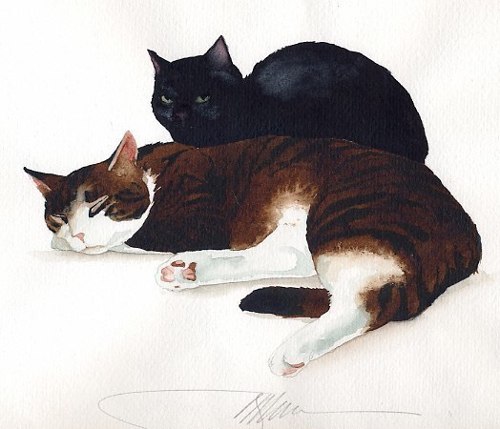
(Scholastic, 1995)
7-Imp: If you teach illustration, can you tell me how that influences your work as an illustrator?
Barry: I teach printing and typography at Smith College but have taught illustration at Rhode Island School of Design. The only influence that comes to mind is that hearing myself articulate solutions and problems inherent in the craft of illustration often clarifies my own issues and problems back at home in the studio.
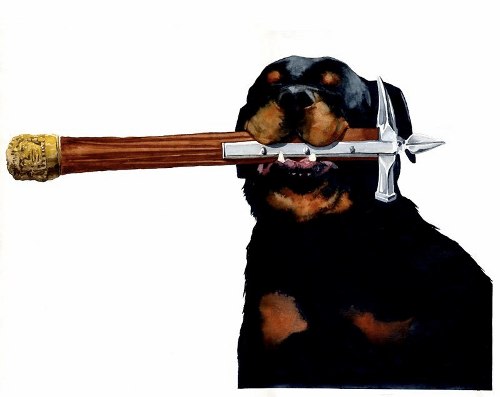
Dogs of Myth: Tales from Around the World (Simon & Schuster, 1999)
7-Imp: Any new titles/projects you might be working on now that you can tell me about?
Barry: Once Upon a Twice (Denise Doyen, Random House) is just out. It’s a nonsense poem that is also a cautionary tale for mice, warning them not to go out in the bush at night. It’s a marvelously witty poem that is challenging for kids, but we’ve heard two or three kids who have memorized the entire poem. We just found out that it has been chosen by Kirkus as one of the Best Books for Children of 2009. Makes us proud.
(Click to enlarge spread.)
-asham’d; / He rambles past the haven reeds.”
(Click to enlarge spread.)
(Click spread to enlarge.)
I am just about to do the jacket painting for O, Harry! (Roaring Brook), another poem, but this one written by Maxine Kumin. It’s about a horse, named Harry, who has a calming effect on the high-strung show horses he stables with. Along comes the son of the owner, a real hellion, who learns to be calm after meeting Harry. And I am just beginning work on Christmas in the Time of Billy Lee (Jerdine Nolen, Disney/Hyperion), a story about an African-American girl, whose invisible companion introduces her to snow and the miracles of Christmas.

 Our table’s set now for seven questions over breakfast, and we’ve got coffee and eggs all set. Let’s get a bit more detailed, and I thank Barry again for stopping by.
Our table’s set now for seven questions over breakfast, and we’ve got coffee and eggs all set. Let’s get a bit more detailed, and I thank Barry again for stopping by.
1. 7-Imp: What exactly is your process when you are illustrating a book? You can start wherever you’d like when answering: getting initial ideas, starting to illustrate, or even what it’s like under deadline, etc. Do you outline a great deal of the book before you illustrate or just let your muse lead you on and see where you end up?
Barry: First of all, I am offered a job by a publisher. I suppose that goes without saying, but I sometimes generate books on my own—books that are published in limited editions and with original art. Once the job has been accepted, contracts written and signed, I then design my book.

(Aladdin Fiction, 2000)
I set the type and leave spaces for images. (And mind you that I don’t have a clue as to what those images are at this point.) The fact is that my books are usually type-driven rather than picture-driven. (I hope that that is never apparent, because if I’ve done my typography well, the reader should never notice it. It’s a very subtle art form.) I consider myself a typographer more than an illustrator and can get really picky about the type and its composition.
Once the typographic “cradle” has been constructed, I begin filling in the blanks I’ve left for images. These days I do my compositions in the computer. I build what, if done with paper, would be called a collage. I borrow and steal bits and pieces of photographs from here and there, often photos I made myself, and arrange them into what I hope is a coherent and harmonious picture.
Once the composition has met my standards (and the approval of the editor), I trace the image off onto hand-made watercolor papers and paint it. I’ve never had any instruction in watercolor, so I don’t know what I am supposed to do or not to do. I often start off with the darkest rather than the lighter areas, which is pretty much backwards from what most watercolorists do.
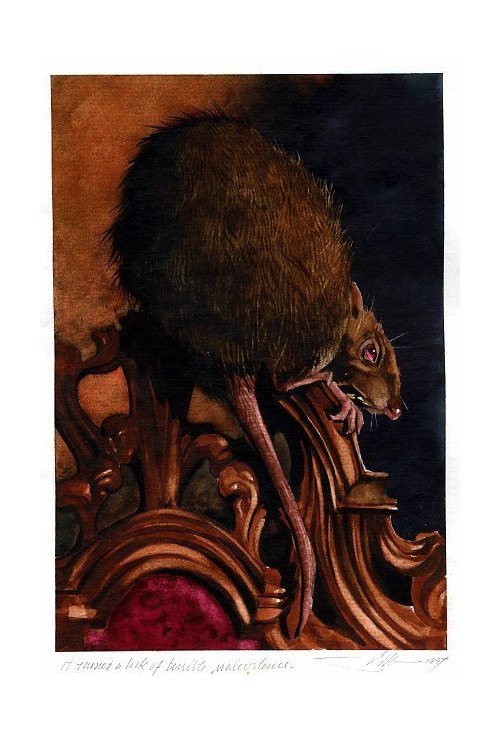
(HarperCollins, 1998)
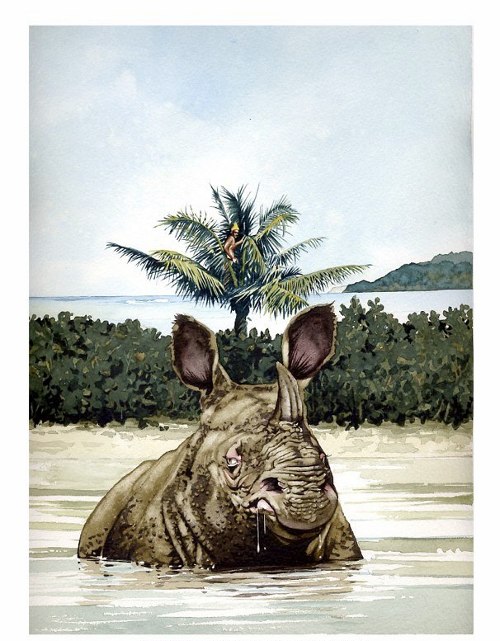
(HarperCollins, 1996)
2. 7-Imp: Describe your studio or usual work space.
{Ed. Note: Pictured below is Moser’s drawing of the legendary Jabberwock.}
 Barry: My house, which I designed and built twenty-three years ago, is on a hill in the middle of acres and acres of woods. The studio is the largest room in the house. It is two-storied, with a cat walk that defines the second floor. This is where we store inventory. My bedroom opens off the cat walk. Downstairs there are three work areas: my assistant’s desk and files; my desk and reference book, where I do my computer work; and my work table where I paint and engrave. My work table faces a fireplace that has a Käthe Kollwitz etching hanging above the mantle. Behind my work table (an antique English desk with a portable drawing board) are three large windows that look out into the woods. On either side of the fireplace are book shelves that house a thousand or so books. Part of the left-hand book case is where my sound system is, and that might just be the most important part of the studio, given my devotion to and need for music (Palestrina, Bach, Mozart, Sibelius, etc.). There are oriental carpets on the floor and scads of pictures on the high, two-story wall facing the area where my assistant works. Adjacent to that wall of pictures is a wall of glass that is twenty-odd feet high. It faces north, so the light in the studio is always constant.
Barry: My house, which I designed and built twenty-three years ago, is on a hill in the middle of acres and acres of woods. The studio is the largest room in the house. It is two-storied, with a cat walk that defines the second floor. This is where we store inventory. My bedroom opens off the cat walk. Downstairs there are three work areas: my assistant’s desk and files; my desk and reference book, where I do my computer work; and my work table where I paint and engrave. My work table faces a fireplace that has a Käthe Kollwitz etching hanging above the mantle. Behind my work table (an antique English desk with a portable drawing board) are three large windows that look out into the woods. On either side of the fireplace are book shelves that house a thousand or so books. Part of the left-hand book case is where my sound system is, and that might just be the most important part of the studio, given my devotion to and need for music (Palestrina, Bach, Mozart, Sibelius, etc.). There are oriental carpets on the floor and scads of pictures on the high, two-story wall facing the area where my assistant works. Adjacent to that wall of pictures is a wall of glass that is twenty-odd feet high. It faces north, so the light in the studio is always constant.
 3. 7-Imp: As a book lover, it interests me: What books or authors and/or illustrators influenced you as an early reader?
3. 7-Imp: As a book lover, it interests me: What books or authors and/or illustrators influenced you as an early reader?
Barry: I was not an early reader. I did not begin to read seriously until I was an adult, and that happened as a direct result of learning to set type—the most intense form of reading there is: upside down and backwards. That happened when I was studying with Leonard Baskin, and his work was a powerful influence on me. The Wyeths had influenced me long before I began to read seriously. So had Mark Rothko, Adolph Gottlieb, Franz Kline, and a host of other non-objective, expressionistic painters. As well as the old masters, which almost goes without saying: Rembrandt, Velázquez, Carravagio, Whistler, Kollwitz, Sargent, Homer. The list is long. Today, I am influenced most of all by a writer: Flannery O’Connor {as depicted here by Moser}. Her work ethics, which she writes about in her letters. Her philosophies about her work have been and continue to be a deep and profound inspiration.
4. 7-Imp: If you could have three (living) illustrators—whom you have not yet met—over for coffee or a glass of rich, red wine, whom would you choose?
Barry: I’d prefer a martini myself…You know, I’ve thought about this question for two days and cannot think of a single name. I think I’ve met them all at one point or another. It comes with living a long life. There is a Canadian engraver/illustrator that I’d really enjoy having a drink with. His name is Jim Westergard. Thing is, we’ve had a lively correspondence for a few years now, but we’ve never met. So, according to the way the question was framed, he counts.
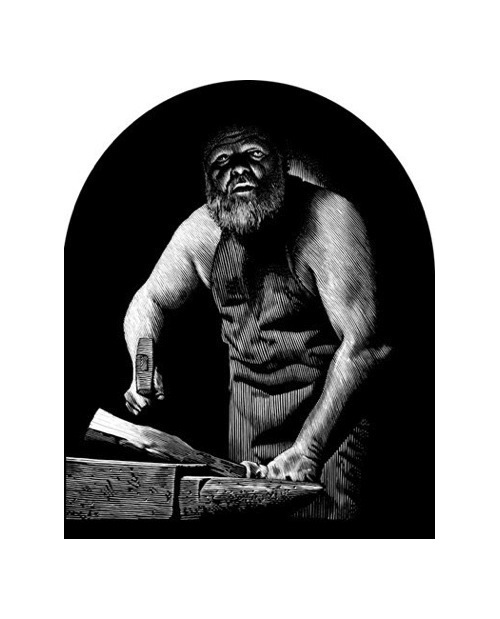
Walker Percy and Nathaniel Hawthorne.}
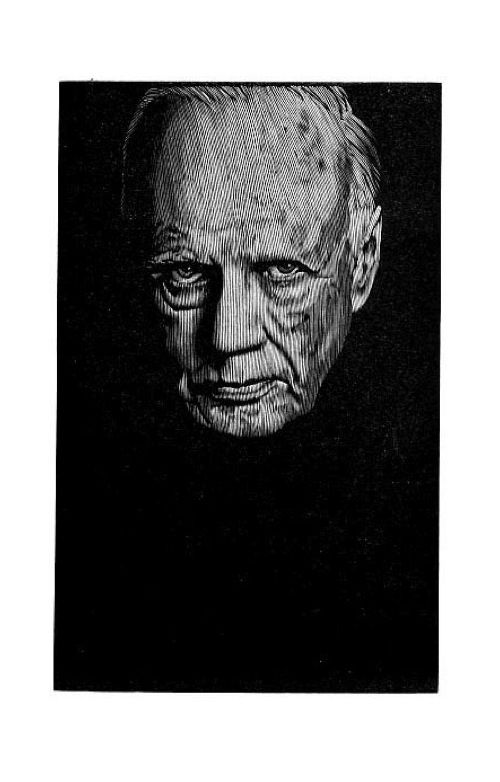

5. 7-Imp: What is currently in rotation on your iPod or loaded in your CD player? Do you listen to music while you create books?
Barry: I addressed this earlier in a general sort of way, but yes, I listen to music a lot. Not always, though. If I am inventing an image or if I am writing (like now), I do not listen to music. And that’s because I LISTEN to music. For me, it’s a lot more than background noise. In fact, I should have said in answering your earlier question about influences that I feel that Bach has been perhaps he greatest influence on my work of all. I wish I could articulate that. I can’t. Perhaps when I am older (I’m almost 70 now) I’ll understand well enough to be able to write about it. The CDs in my CD player at the moment…I’ll have to go check…are the seven symphonies of Jean Sibelius as well as his Kullervo Symphony of 1892.
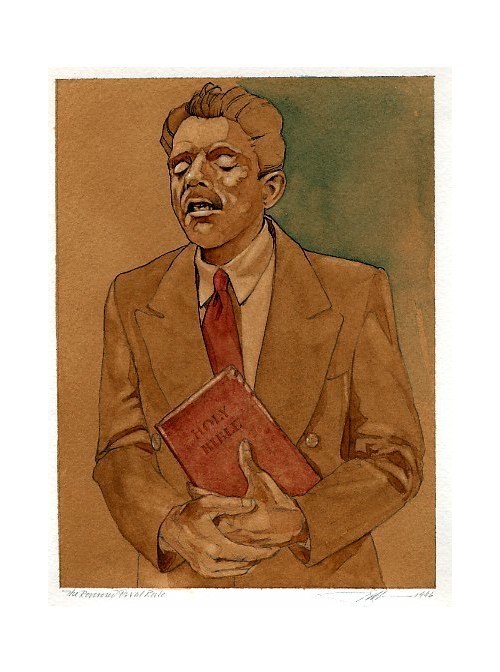
An Illustrated Retelling of O. Henry’s the Gift of the Magi
(Little Brown & Company, 1997)
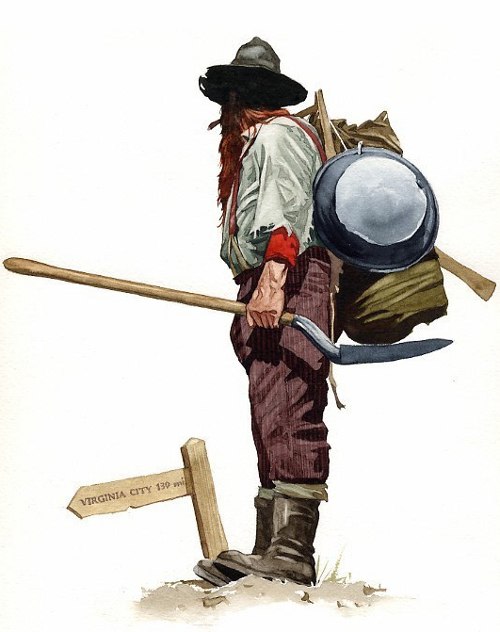
by Kathryn Lasky (Harcourt, 1998)
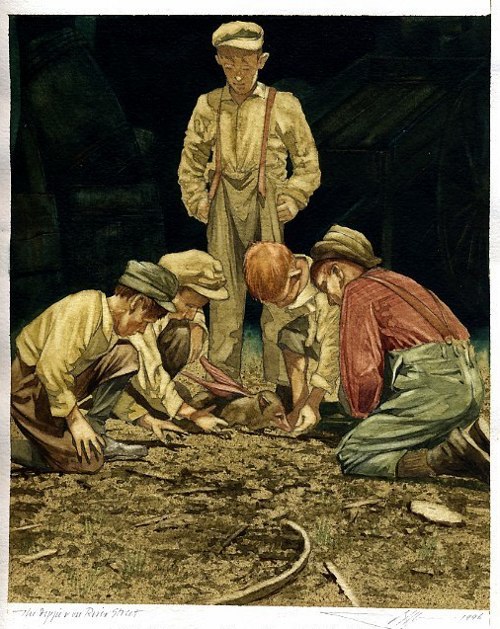
6. 7-Imp: What’s one thing that most people don’t know about you?
Barry: That I am a recovering racist. Now that’s going to require a bit of explanation:
 I grew up in Chattanooga, Tennessee, in the ’40s and ’50s. My family was not well-educated. They did not read much of anything, other than the newspapers, Reader’s Digest, and the Bible. They were all racists of the worst sort (save my mother, who was much more moderate). My grandfather and uncle were both Klansmen. The whole lot of them idolized Joseph McCarthy. I was brought up in this kind of environment. But also understand that that environment was also full of love and kindness to me. I had a happy childhood, for the most part, but the scars that were left on my heart and soul from the hate and bile my family exposed me to have taken a lifetime to get over. And, assuming that I have not yet won the battle as well as I wish I could have, I think of myself as still being in the process of recovering. I’ve made great strides thus far and most folks would never suspect such a background.
I grew up in Chattanooga, Tennessee, in the ’40s and ’50s. My family was not well-educated. They did not read much of anything, other than the newspapers, Reader’s Digest, and the Bible. They were all racists of the worst sort (save my mother, who was much more moderate). My grandfather and uncle were both Klansmen. The whole lot of them idolized Joseph McCarthy. I was brought up in this kind of environment. But also understand that that environment was also full of love and kindness to me. I had a happy childhood, for the most part, but the scars that were left on my heart and soul from the hate and bile my family exposed me to have taken a lifetime to get over. And, assuming that I have not yet won the battle as well as I wish I could have, I think of myself as still being in the process of recovering. I’ve made great strides thus far and most folks would never suspect such a background.
This and my struggles with fundamentalist Christianity (of which most my folks adhered to) were the primary reasons I expatriated myself from Dixie in 1967. I did not have the courage to go to Mississippi and register voters, nor do any of the other things my conscience dictated that I should do, so I just left. Packed up my (then) wife and our babies and moved north. I’ve been here ever since. Though, I must say, a big part of my heart still belongs to the South. Not to the hateful and ugly South of my past, but to the manners of the region, the food, the stories, and the writers of those stories: O’Connor, Welty, Wright, Williams, and I could go on and on….
7. 7-Imp: Is there something you wish interviewers would ask you — but never do? Feel free to ask and respond here.
Barry: I really can’t think of anything. I do think I’ve been asked every question known to man and beast, save those that are completely untoward.
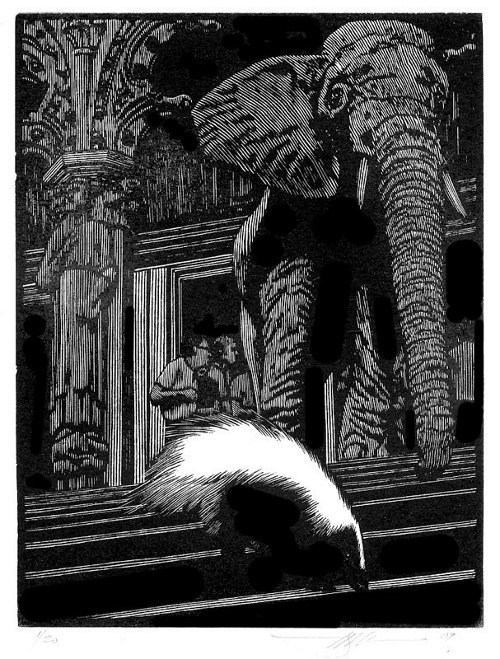
(Paraclete Press, 2007); See here for more information.

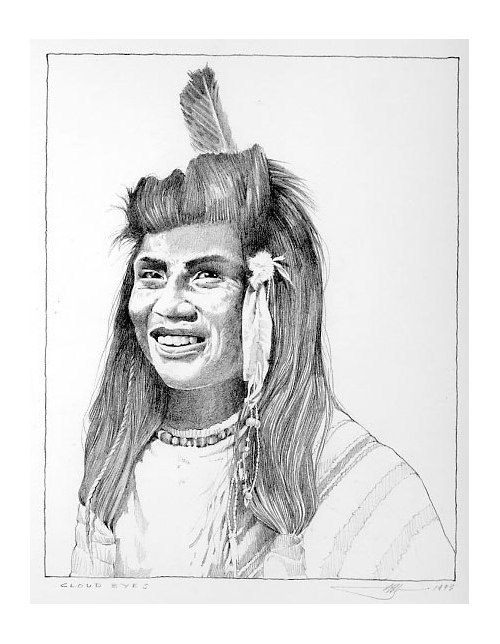
(Harcourt, 1994)

7-Imp: What is your favorite word?
Barry: I’m afraid you couldn’t repeat it.
7-Imp: What is your least favorite word?
Barry: I’ll give you two:
“Awesome.” I mean, the second coming of Christ would be awesome, not blue jeans.
And the word “like,” when used needlessly and without any meaning. I mean, like, well, you know what I mean, man?
7-Imp: What turns you on creatively, spiritually or emotionally?
Barry: Music. Especially ecclesiastical music. And architecture, especially ecclesiastical architecture, like Chratres Cathedral, the cathedral Church of St. John the Divine in New York.
7-Imp: What turns you off?
Barry: Bigots. Arrogance. Certainty. And most high-profile Republicans, which pretty much sums up the first three.
7-Imp: What is your favorite curse word? (optional)
Barry: Why the fuck would you ask this question?
7-Imp: What sound or noise do you love?
Barry: Other than musical sounds, I love to listen to my mastiffs snore….and the sound of the surf gently slapping the shore.
7-Imp: What sound or noise do you hate?
Barry: Rush Limbaugh and his ilk.
7-Imp: What profession other than your own would you like to attempt?
Barry: Type designer, but I’m far too old to entertain a new career.
7-Imp: What profession would you not like to do?
Barry: A politician.
7-Imp: If Heaven exists, what would you like to hear God say when you arrive at the Pearly Gates?
Barry: “Mornin’, Bubba.”
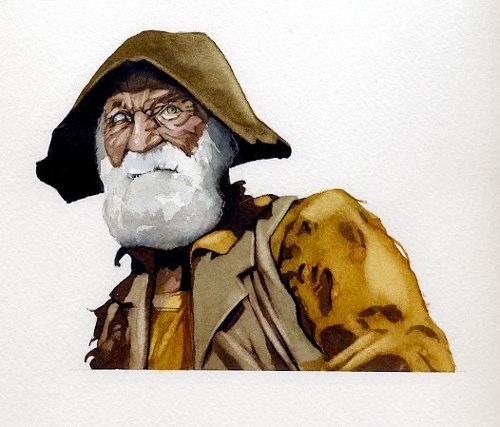
A Treasury to Inspire Our Children (Amistad, 2005)

Animal Tales from America, the West Indies, And Africa
(Blue Sky Press, 1997)
ONCE UPON A TWICE. Copyright © 2009 by Denise Doyen. Illustrations © 2009 by Barry Moser. Published by Random House, New York, NY. All rights reserved.
COWBOY STORIES. Copyright © 2007. Illustrations © 2007 by Barry Moser. Published by Chronicle Books, San Francisco, CA. All rights reserved.
Photos of Moser courtesy of Random House.
All others images used with permission of Barry Moser. All rights reserved. Visit Pennyroyal Press for more information, including price listings for some of the pieces featured here.
The spiffy and slightly sinister gentleman introducing the Pivot Questionnaire is Alfred. He was created by Matt Phelan, and he made his 7-Imp premiere in mid-September. Matt told Alfred to just pack his bags and live at 7-Imp forever and always introduce Pivot. All that’s to say that Alfred is © 2009, Matt Phelan.
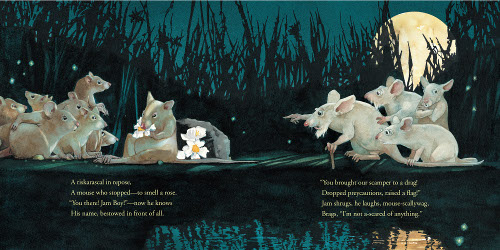
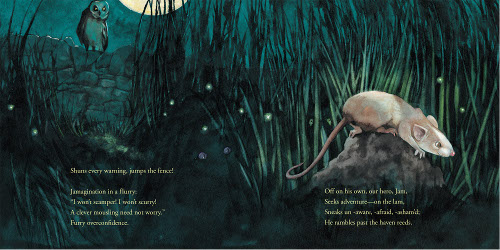


Great illustrations!
I can never believe my eyes when seeing them. Such amazing skills!
Also really enjoyed reading the interview! Thank you!
This interview with Mr. Moser is wonderful. I have long appreciated his work. The insights into his work and personal history are remarkable. Thanks, especially to Mr. Moser, for being so forth-coming about his continuing recovery from growing up in a racist world.
I was NOT expecting “Why the fuck would you ask this question?” Boy, that made me LAUGH.
“The Widow and the Tree” is really something, as is, of course, Once Upon a Twice. The children’s librarians in our system had our annual best books of the year meeting yesterday, and that was one of the ones I was jabberjawing on about, telling them how they all had to look at it right away.
You somehow missed the fact that Barry is enormous fun to be with, a good companion, good neighbor, and the house is to die for. He is also a constant pusher, that is he pushes one to define terms, to think more clearly about stuff, and to defend one’s territory or shift to his!
Also, he’s done books with some of his kids and grandkids and–to my great delight–me.
Jane
Great post!
Love the artwork, really inspiring!
Giant. No semester goes by without me introducing Barry Moser to my students.
I met Barry when I was a pup and he is one amazing artist/person. I have been a fan of his dramatic and skillful work since then. I strive to become such a master of my craft as he is.
I was a student of the Canadian printmaker Jim Westergard who Barry mentions as the person he’d like to meet. He has been a profound influence on my journey as an artist also. He would be a great person to interview as well. This is his website:
http://www.telusplanet.net/public/jimwest/
[…] the record for my favorite Pearly-Gates Pivot response of all time thus far here at 7-Imp. When he stopped by in 2009, his response to the final Pivot question—”If Heaven exists, what would you like to […]
[…] the record for my favorite Pearly-Gates Pivot response of all time thus far here at 7-Imp. When he stopped by in 2009, his response to the final Pivot question—”If Heaven exists, what would you like to […]
[…] Hands down, my biggest kick of the week was an opportunity to chat with Barry Moser about Appalachian children’s literature, as a favor for some friends at UT in Knoxville, who […]
[…] of Roald Dahl, Dr. Seuss, and Richard Scarry, and later, she became excited about Edward Gorey, Barry Moser, Jon Scieszka/Lane Smith, or the Brothers […]